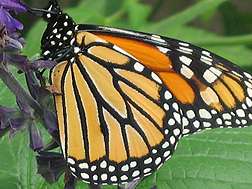Trapping weevils and saving monarchs

Ensuring the monarch butterfly's survival by saving its milkweed habitat could result from U.S. Department of Agriculture (USDA) studies initially intended to improve detection of boll weevils with pheromone traps.
Charles Suh and his colleagues at the Agricultural Research Service (ARS) Areawide Pest Management Research Unit in College Station, Texas, have found a pheromone formula that is attractive to a major milkweed pest, the milkweed stem weevil.
The discovery stems from research originally designed to help improve pheromone lures used in Texas to monitor the boll weevil, a major pest of cotton. The lures haven't always been effective, so the researchers worked with the pheromone manufacturer to improve the pheromone lure used in the traps.
The researchers set up traps along roads in Texas to compare the standard and experimental lures for attracting boll weevils. They checked the traps once a week from mid-May to mid-June, replacing the lures every other week.
They soon found that the experimental lures were attracting a type of weevil distinctly different from boll weevils. The weevils were identified as milkweed stem weevils, Rhyssomatus lineaticollis. The researchers initially discounted the number of milkweed stem weevils found in the traps, but it soon became obvious that more milkweed stem weevils were being captured than boll weevils. Overall, four times more milkweed weevils were captured in traps with the experimental lures than with standard lures.
Monarch butterflies are often admired for their eye-catching wings and transcontinental migrations. Conservationists concerned about the potential loss of milkweed habitat have recommended planting milkweed in yards and gardens. Adult monarch butterflies feed on the nectar of various wild flowers when they migrate from the Midwestern United States to the mountains of central Mexico. But their larvae feed on milkweed, making the plant a necessity for the butterfly's lifecycle.
The discovery, reported in Southwestern Entomologist, could be used to develop a trap-based system for detecting milkweed weevil populations, monitoring their movements, and helping conserve rare types of milkweed.
More information: www.bioone.org/loi/swen
Provided by United States Department of Agriculture

















